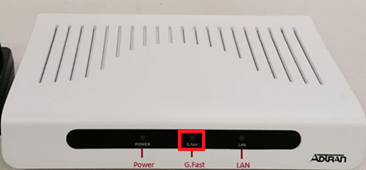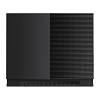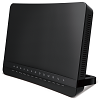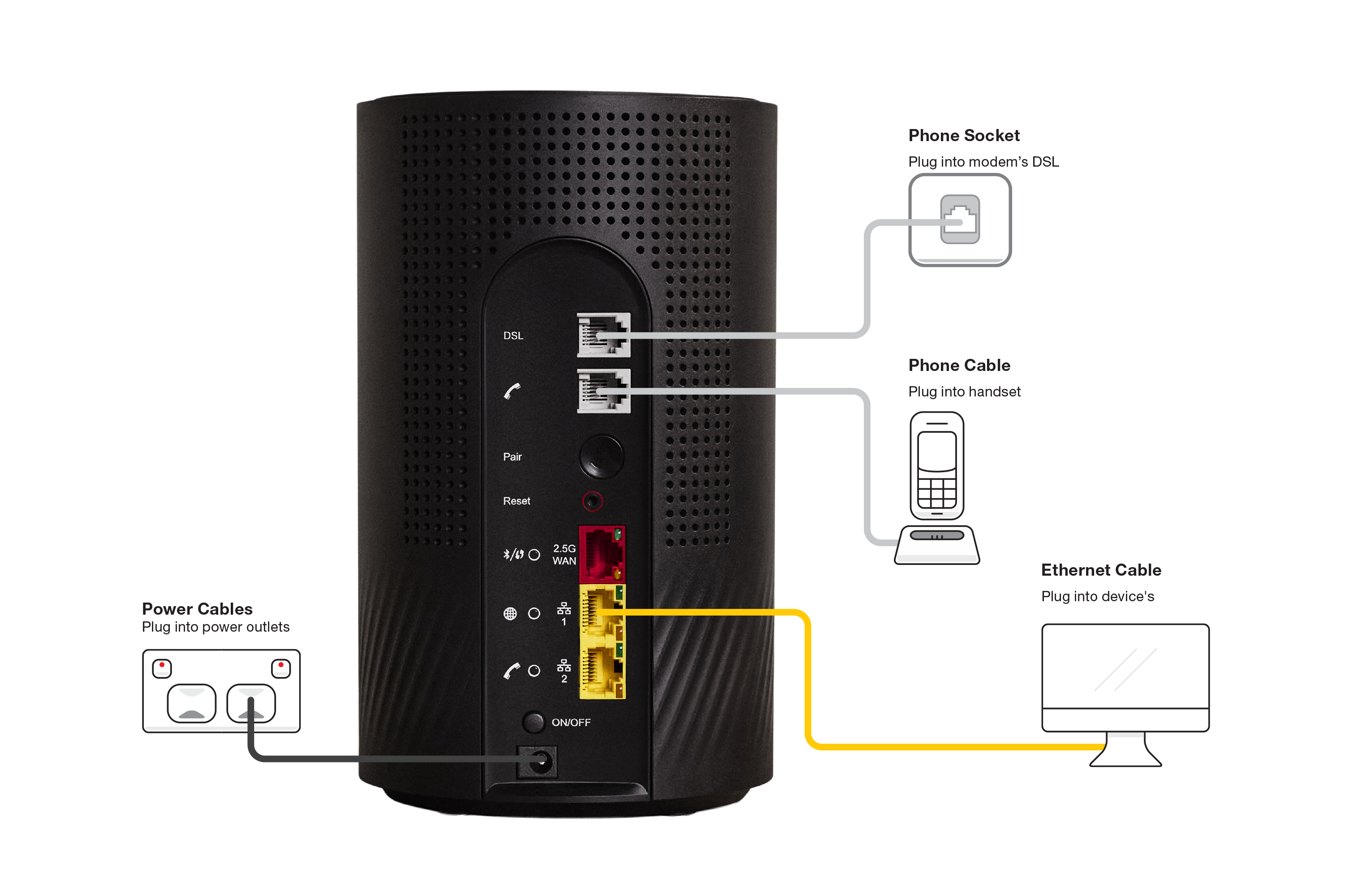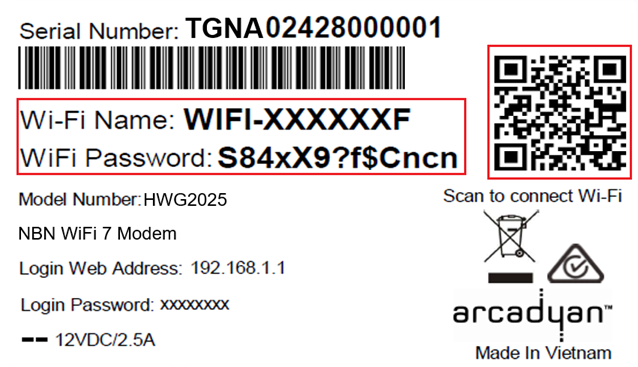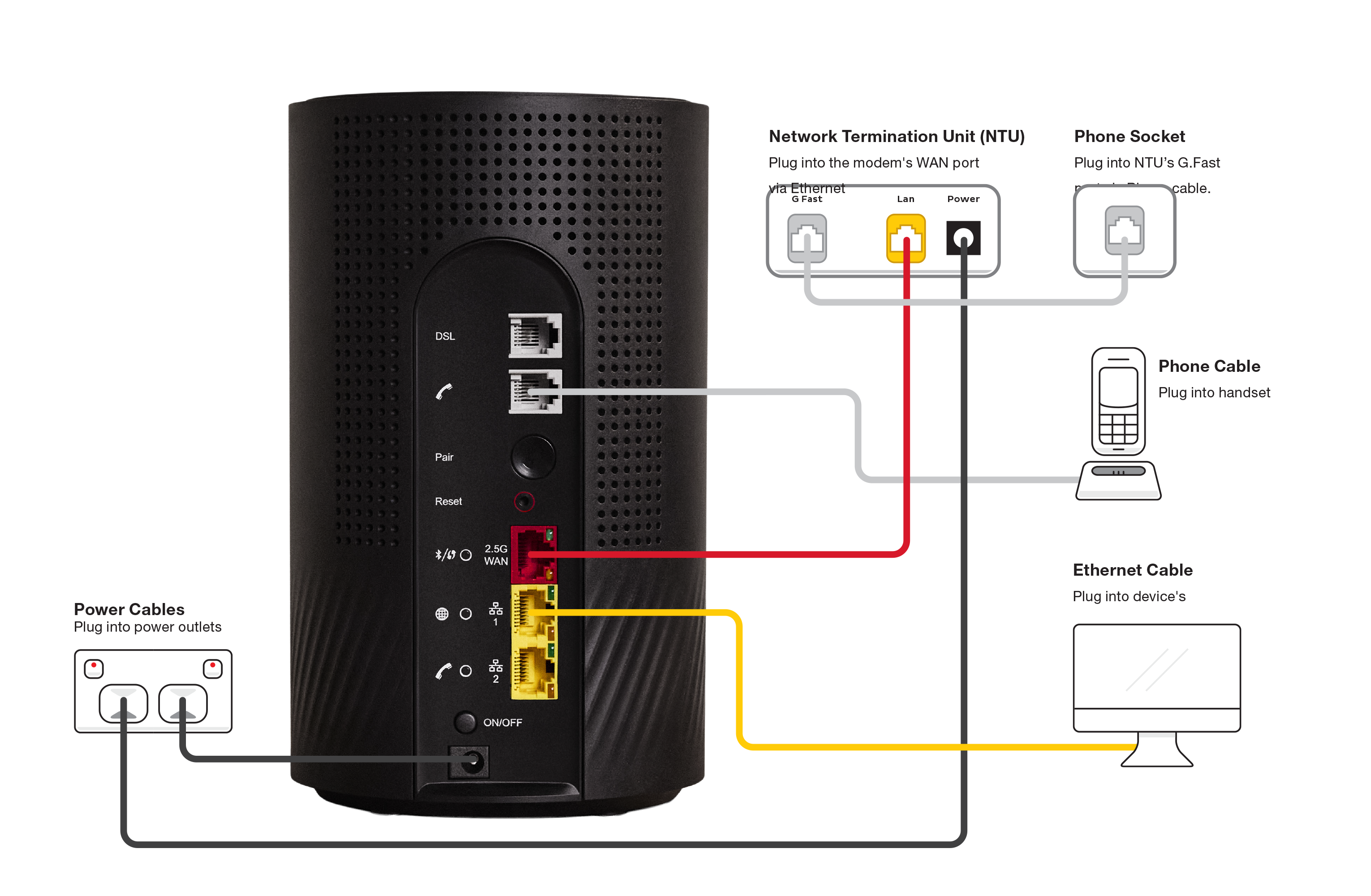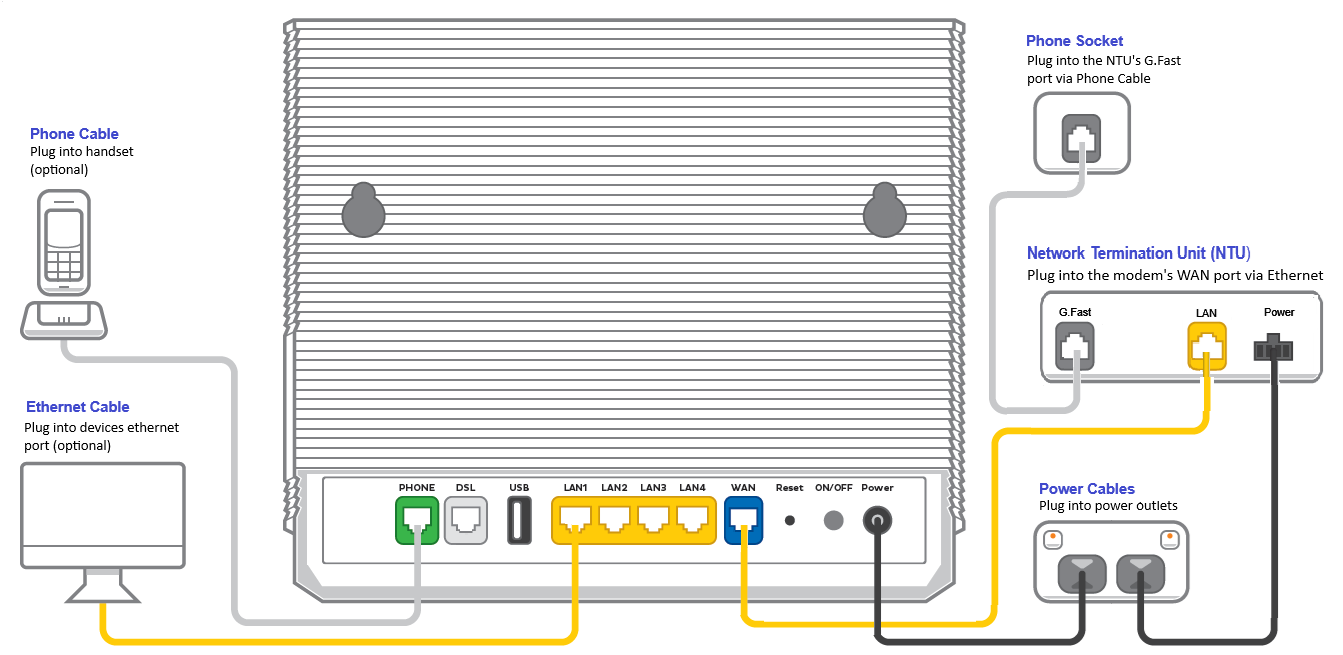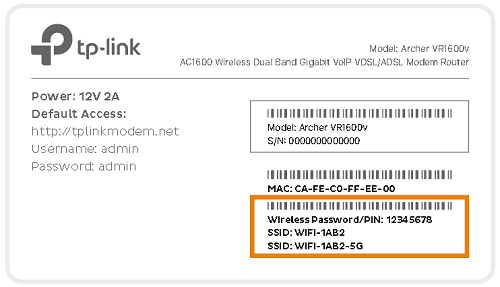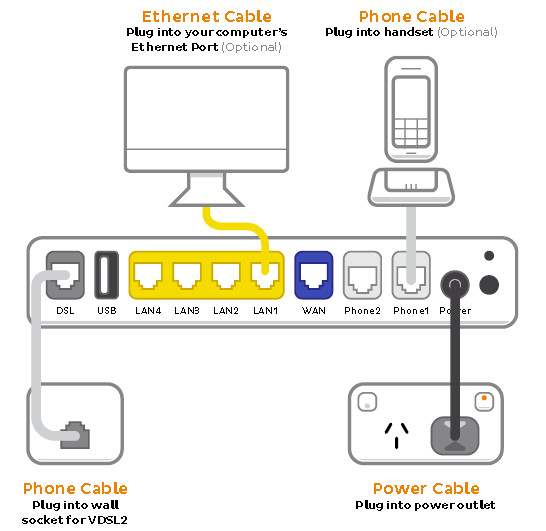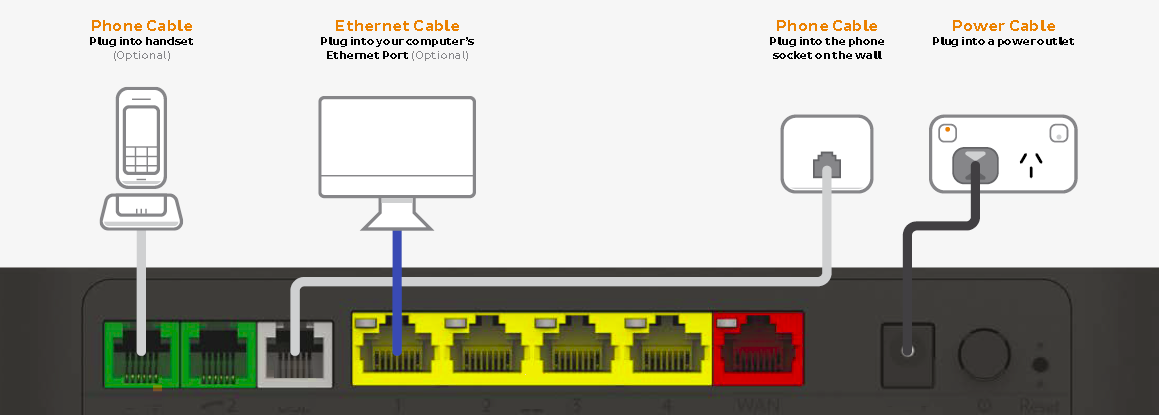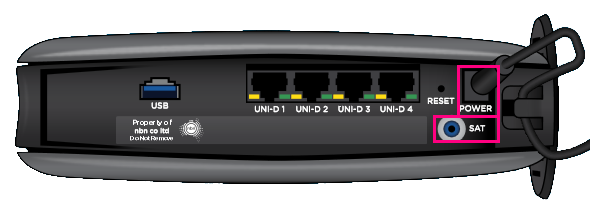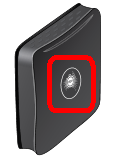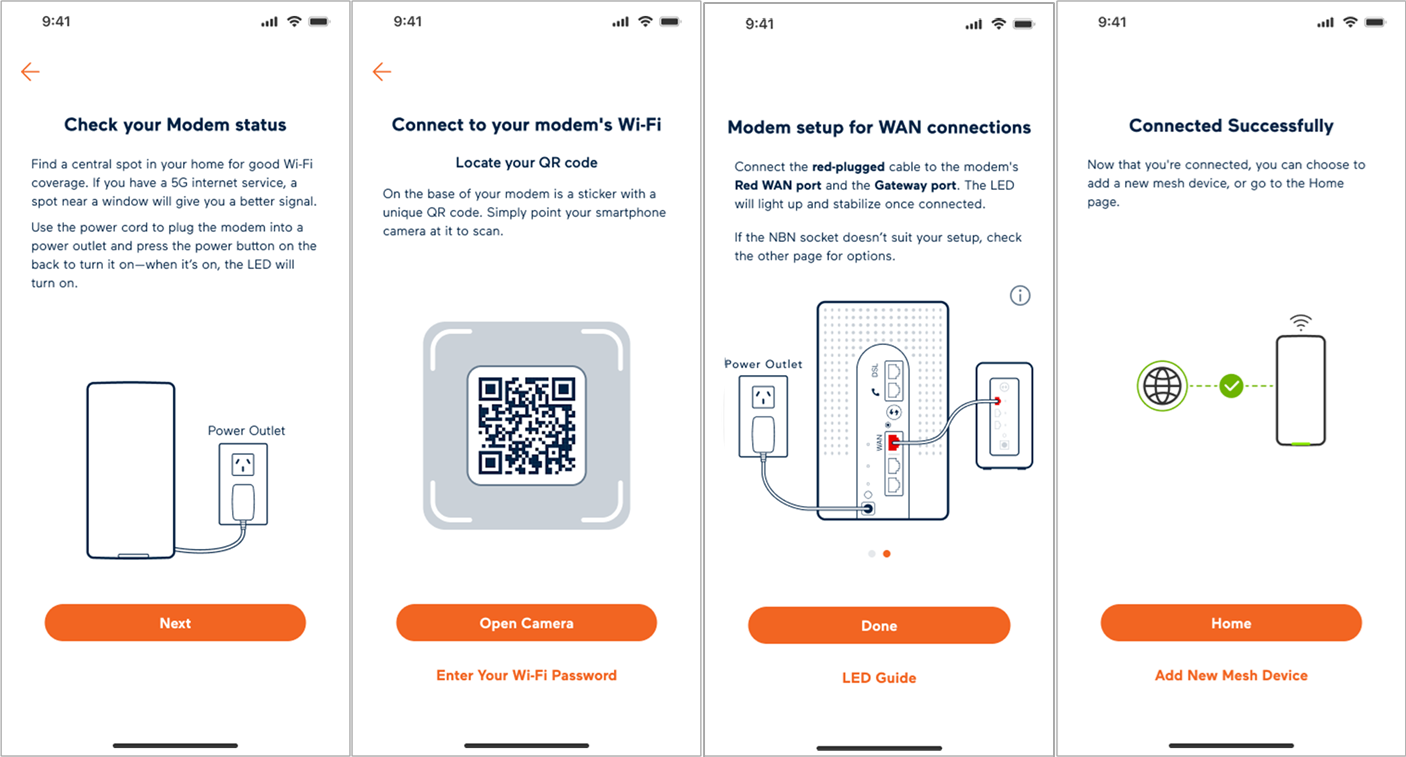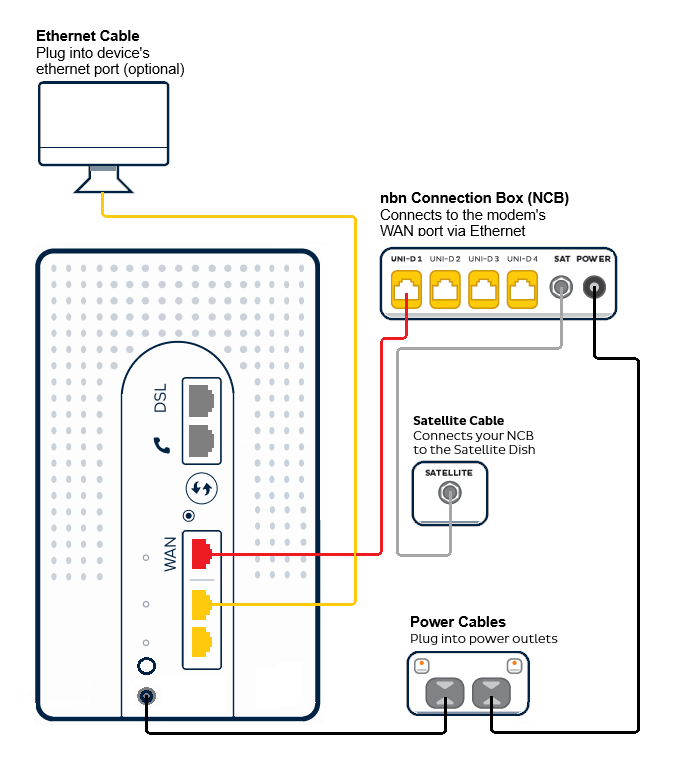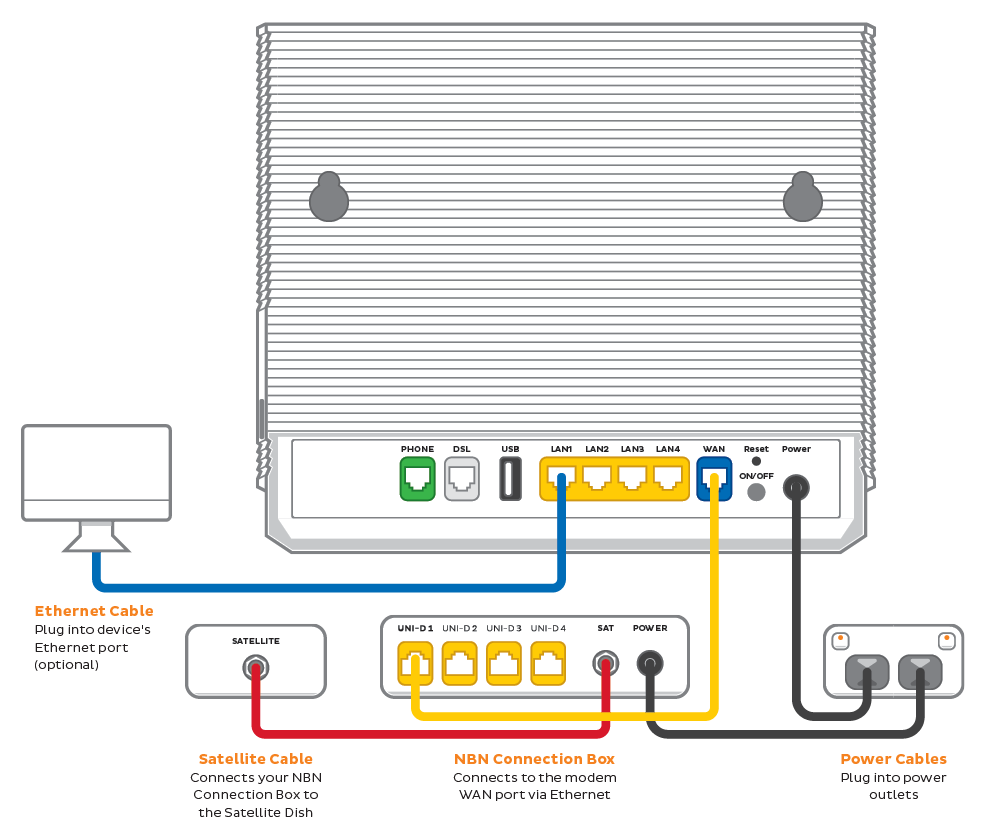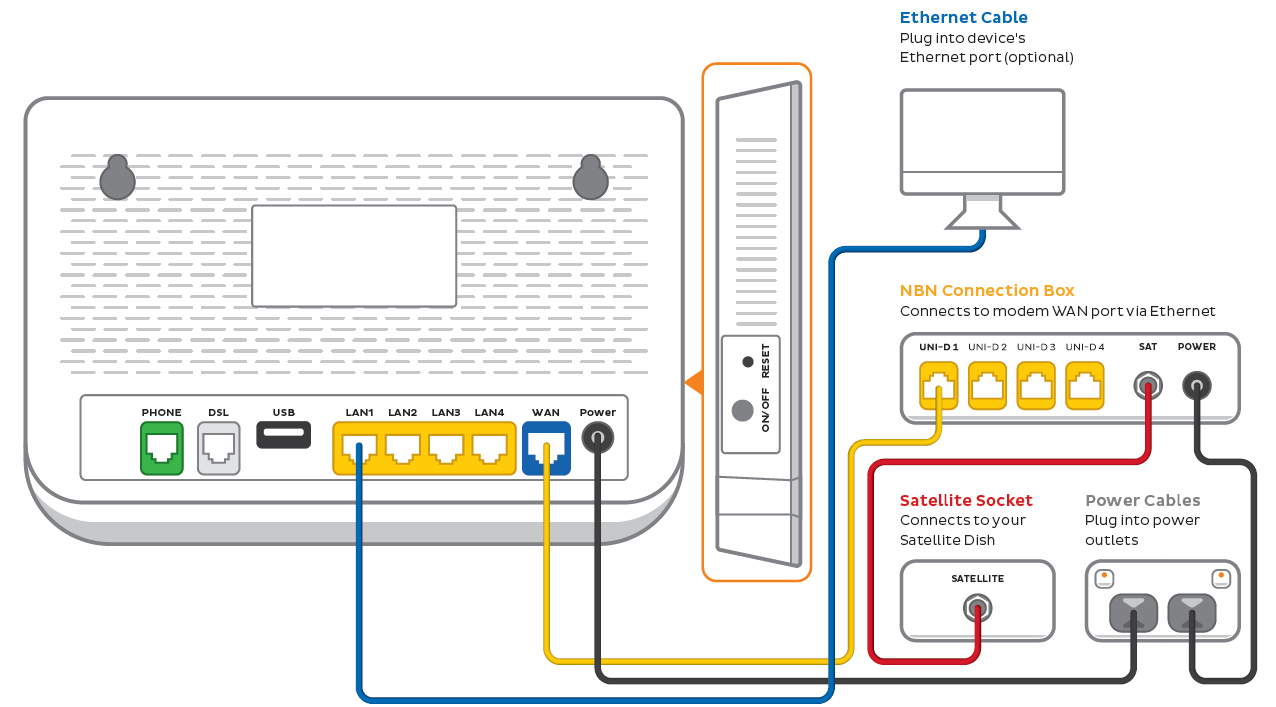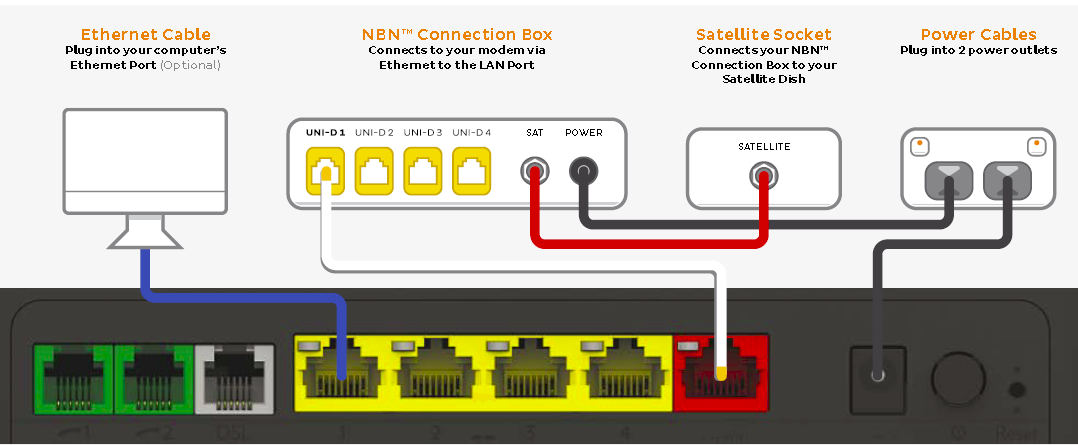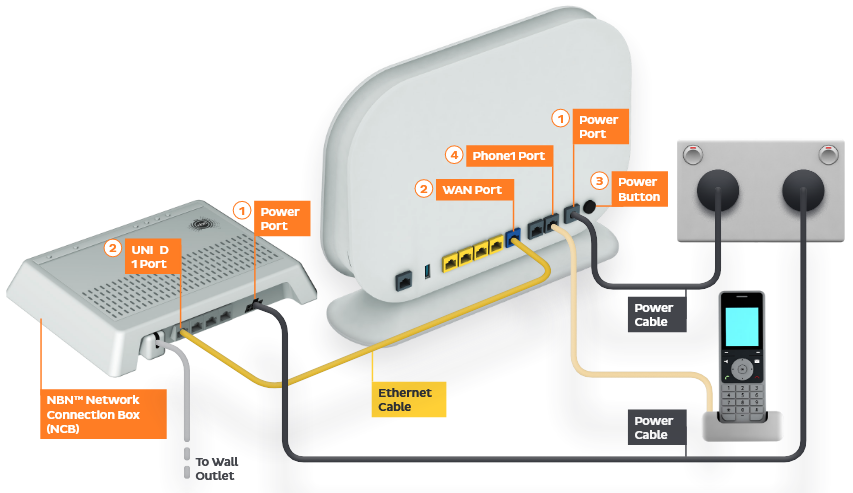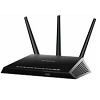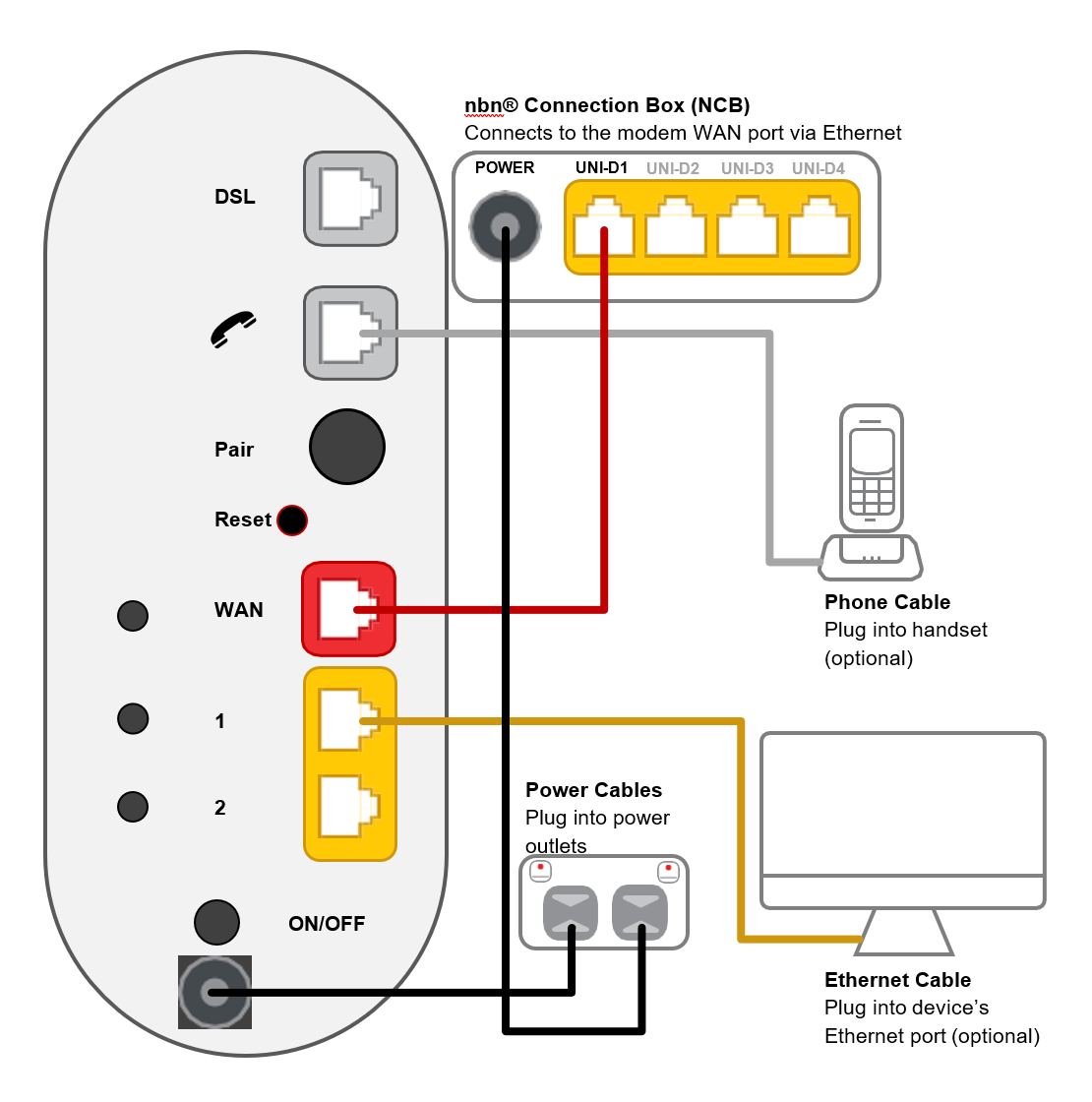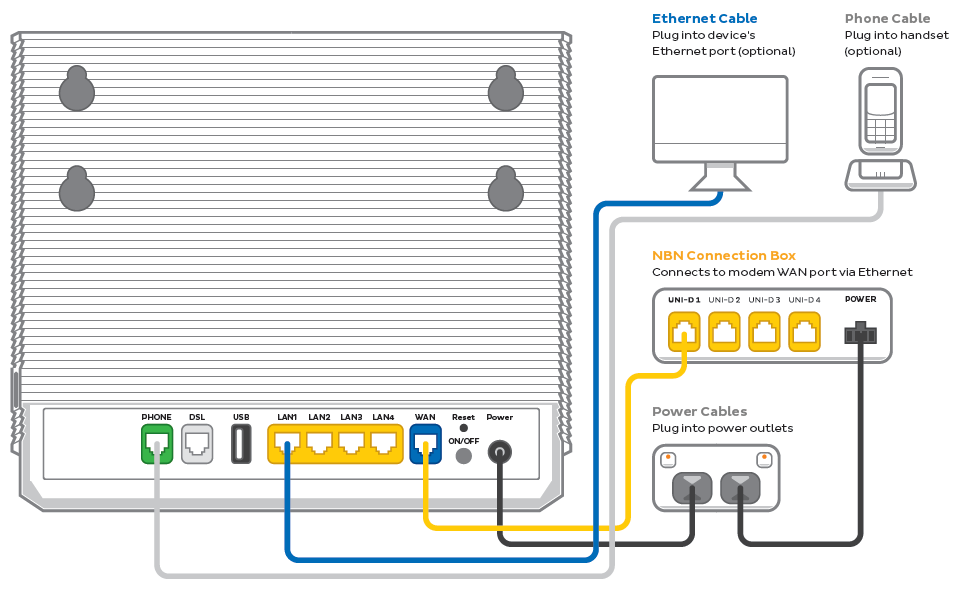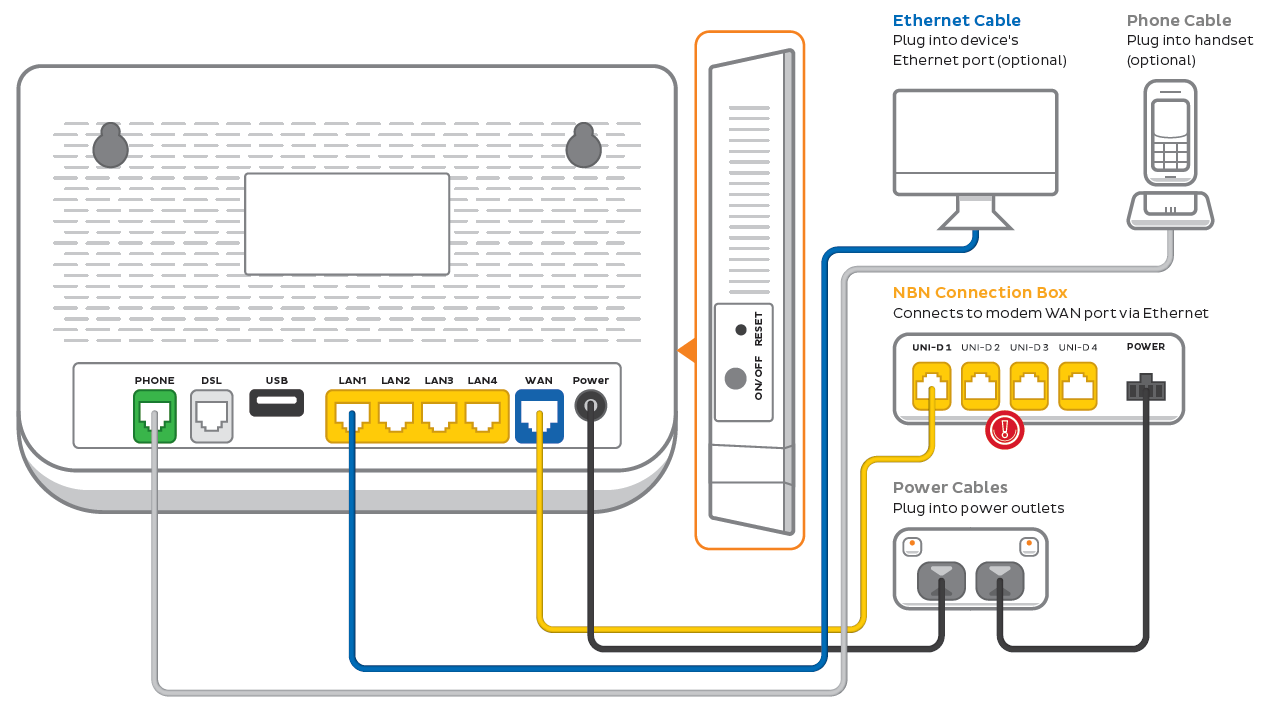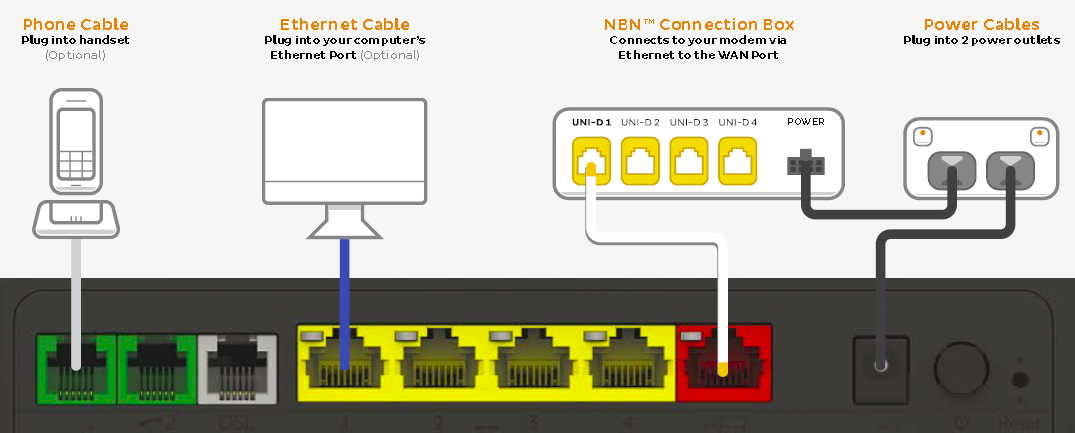If your Ultra Broadband VDSL2 service is having dropouts, it means your internet will go offline and come back online intermittently. These steps will help you identify the issue.
- Your service may just be affected by an outage or planned maintenance. You can check your address on our Network Status page.
If there is an outage or planned maintenance, the results will give you an estimated fix time. -
Do you have any devices connected to your modem with an Ethernet cable? If these devices stay connected when devices on Wi-Fi drop out, switch to troubleshooting Wi-Fi Dropouts.
- Find your VDSL2 modem and make sure the cables are plugged in securely and not damaged. Our setup guide will show you how to plug in.
You’ll need to replace any broken or chewed cables. - If you have a Network Termination Unit (NTU) and you notice any of these status light behaviours, please call us on 13 22 58.
The phone cable for an NTU must not be longer than 1 metre.
ZyXel GM4100-B0 G.Fast NTU - Slow blinking green G.Fast light
Adtran® 422G G.Fast NTU - Flashing green G.Fast light - Still getting dropouts? Please call us on 13 22 58 and we’ll help you.
If your Ultra Broadband VDSL2 service is offline, you won’t be able to visit a website, browse, stream, or download. Email and any other services that use the internet will not work. These steps will help you identify the issue.
- Your service may just be affected by an outage or planned maintenance. You can check your address on our Network Status page.
If there is an outage or planned maintenance, the results will give you an estimated fix time. - Find your Cable modem and make sure the cables are plugged in securely and not damaged. Our setup guide will show you how to plug in.
You’ll need to replace any broken or chewed cables. - Turn off your modem’s power outlet for at least 10 seconds.
- Turn the outlet back on and wait for your modem’s Internet light to come on, then see if you can visit a website.
- If you have a Network Termination Unit (NTU) and you notice any of these status light behaviours, please call us on 13 22 58.
The phone cable for an NTU must not be longer than 1 metre.
ZyXel GM4100-B0 G.Fast NTU - Slow blinking green G.Fast light
Adtran® 422G G.Fast NTU - Flashing green G.Fast light - Do you have any devices connected to your modem with an Ethernet cable? If these devices can visit a website but devices on Wi-Fi can’t, switch to troubleshooting Wi-Fi No Connection.
- If you can view websites on some devices but not others, even when they’re both connected the same way, you may need to fix some browser settings. Check out our guide on Browsing issues.
- Still can't get online? Please call us on 13 22 58 and we’ll help you.
If your Ultra Broadband VDSL2 service is running slowly, these steps will help you identify the issue.
- Your service may just be affected by planned maintenance. You can check your address on our Network Status page.
If there is planned maintenance, the results will give you an estimated fix time. - Find your VDSL2 modem and turn off its power outlet for at least 10 seconds.
-
Turn the outlet back on and wait for your modem’s Internet light to come on, then run a speed test.
-
Do you have any devices connected to your modem with an Ethernet cable? If speeds on these devices are fine but devices on Wi-Fi are slow, switch to Troubleshooting Wi-Fi speed.
-
Make sure that the device you’re using to run speeds tests is the only one connected to your modem. Unplug all other devices from your modem’s Ethernet ports and turn off other devices that are connected to the Wi-Fi.
-
On your one device, close all other apps using the internet, then run a speed test.
-
If your speed has improved on a single device, you may need to upgrade your VDSL2 plan to get enough bandwidth to support more apps or devices.
You can change your plan in Toolbox or call us on 13 19 17.
-
Make sure your modem’s Ethernet cables are in good condition, with “CAT6” or “CAT5e” printed on them.
Older Cat5 Ethernet cables are not recommended for Cable services. You’ll need to replace any broken or chewed cables.
-
Run a scan on your antivirus/anti-malware software. If your software includes any firewalls, temporarily disable them and run a speed test to see if they’re slowing down your internet.
If any infections are detected, make sure they are quarantined and removed. Contact your software’s Customer Support if you need help.
-
Still getting slow speeds? Please call us on 13 22 58 and we’ll help you.
Your modem will take care of the hard stuff like internet settings, but we’ll need your help to plug it in. The main cables you need will come in the box, and you can grab extra Ethernet cables from the shops if you need them.
Choose your modem (with or without NTU) to get started:
Wi-Fi Max Modem
- Wait for a message from us asking you to plug in your modem. We need to get your connection ready on our side first.
- Use the power cable to connect your modem's Power port to a power outlet.
- Use the phone cable to connect your modem’s grey DSL port to your phone wall socket.
- Turn on the power outlet and press your modem’s ON/OFF button.
- To use your VDSL2 phone service, just plug a handset into your modem’s grey Phone port.
- Leave your modem alone for 20 minutes while it runs through its automatic setup.
- Check the light on the front of your modem. If it’s green, you’re online and you can start connecting your devices.
No green light? Call us on 1300 997 274 and we can help you out. - It’s easy to set up your home network by downloading the My Internet Connect App (Android / iOS). To connect your devices to Wi-Fi, you have these options:
- Use the default Wi-Fi name and Wi-Fi Password on your modem's barcode sticker.
- Use a smartphone to scan the QR code on your modem’s barcode sticker.
- Enable Wi-Fi Protected Setup (WPS) on your device then press the Pair button on the back of your modem for 3 seconds.
If you want to change your Wi-Fi name or password, see this guide.
- For online gaming or HD/4K streaming, Ethernet is better than Wi-Fi. If you have extra Ethernet cables, you can connect up to 2 devices to your modem’s yellow LAN ports.
- You’re now good to go.
If you don’t want to keep your old modem, see if your local council has any eWaste recycling facilities.
Wi-Fi Max Modem with a Network Termination Unit (NTU)
- Wait for a message from us asking you to plug in your modem. We need to get your connection ready on our side first.
- Use the power cables to connect the Power ports on your modem and NTU to power outlets.
- Use an Ethernet cable to connect your modem’s red WAN port to your NTU's LAN 1 port.
Older NTUs may have a LAN port instead. Learn more. - Use the phone cable to connect your NTU's G.Fast port to your phone wall socket.
- Turn on both power outlets and press your modem’s ON/OFF button.
- To use your VDSL2 phone service, just plug a handset into your modem’s grey Phone port.
- Leave your modem alone for 20 minutes while it runs through its automatic setup.
- Check the light on the front of your modem. If it’s green, you’re online and you can start connecting your devices.
No green light? Call us on 1300 997 274 and we can help you out. - It’s easy to set up your home network by downloading the My Internet Connect App (Android / iOS). To connect your devices to Wi-Fi, you have these options:
- Use the default Wi-Fi name and Wi-Fi Password on your modem's barcode sticker.
- Use a smartphone to scan the QR code on your modem’s barcode sticker.
- Enable Wi-Fi Protected Setup (WPS) on your device then press the Pair button on the back of your modem for 3 seconds.
If you want to change your Wi-Fi name or password, see this guide.
- For online gaming or HD/4K streaming, Ethernet is better than Wi-Fi. If you have extra Ethernet cables, you can connect up to 2 devices to your modem’s yellow LAN ports.
- You’re now good to go.
If you don’t want to keep your old modem, see if your local council has any eWaste recycling facilities.
VX420-G2V Modem
- First, make sure you’ve got a message from us asking you to plug in your modem. We need to get your connection ready on our side before you plug in.
- Use the power cable to connect your modem's Power port to a power outlet and press your modem's ON/OFF button.
- Use the phone cable to connect your modem's grey DSL port to your phone wall socket.
- Leave your modem alone for 15 minutes while it runs through its automatic setup.
- Check the Internet light on your modem. If it's green, you're online and you can start connecting your devices
No green light? Call us on 13 22 58 and we can help you out. - The default Wi-Fi name (SSID) and Wireless password/PIN is on your modem’s barcode sticker. If you want to change your Wi-Fi name or password, use this guide.
- Your devices will automatically connect to the best Wi-Fi possible. If your Wi-Fi’s running slow, check out Improving Wi-Fi Signal.
- For online gaming or HD/4K streaming, Ethernet is better than Wi-Fi. If you have extra Ethernet cables, you can connect up to 4 devices to your modem’s yellow LAN ports.
- If you want to use your VDSL2 Phone service, plug a VoIP-compatible handset into your modem’s green Phone port.
VX420-G2V Modem with G.Fast NTU
The Adtran® G.Fast NTU is supplied with our ULTRA VDSL Max plan.
- First, make sure you’ve got a message from us asking you to plug in your modem. We need to get your connection ready on our side before you plug in.
- Use the power cables to connect your modem and NTU's Power ports to power outlets, then press your modem's ON/OFF button.
- Use the Ethernet cable to connect your modem’s blue WAN port to your NTU's LAN 1 port.
Older NTUs may have a LAN port instead. Learn more. - Use the phone cable to connect your NTU's G.Fast port to your phone wall socket.
- Leave your modem alone for 15 minutes while it runs through its automatic setup.
- Check the Internet light on your modem. If it's green, you're online and you can start connecting your devices
No green light? Call us on 13 22 58 and we can help you out. - The default Wi-Fi name (SSID) and Wireless password/PIN is on your modem’s barcode sticker. If you want to change your Wi-Fi name or password, use this guide.
- Your devices will automatically connect to the best Wi-Fi possible. If your Wi-Fi’s running slow, check out Improving Wi-Fi Signal.
- For online gaming or HD/4K streaming, Ethernet is better than Wi-Fi. If you have extra Ethernet cables, you can connect up to 4 devices to your modem’s yellow LAN ports.
- If you want to use your VDSL2 Phone service, plug a VoIP-compatible handset into your modem’s green Phone port.
Smart Modem Gateway (VX420-G2H)
- First, make sure you’ve got a message from us asking you to plug in your modem. We need to get your connection ready on our side before you plug in.
- Use the power cable to connect your modem's Power port to a power outlet and press your modem's ON/OFF button.
- The the phone cable to connect your modem's grey DSL port to your phone wall socket.
- Leave your modem alone for 15 minutes while it runs through its automatic setup.
- Check the Internet light on your modem. If it's green, you're online and you can start connecting your devices
No green light? Call us on 13 22 58 and we can help you out. - The default Wi-Fi name (SSID) and Wireless password/PIN is on your modem’s barcode sticker. If you want to change your Wi-Fi name or password, use this guide.
- Your devices will automatically connect to the best Wi-Fi possible. If your Wi-Fi’s running slow, check out Improving Wi-Fi Signal.
- For online gaming or HD/4K streaming, Ethernet is better than Wi-Fi. If you have extra Ethernet cables, you can connect up to 4 devices to your modem’s yellow LAN ports.
- If you want to use your VDSL2 Phone service, plug a VoIP-compatible handset into your modem’s green Phone port.
VX220-G2V Modem
- First, make sure you’ve got a message from us asking you to plug in your modem. We need to get your connection ready on our side before you plug in.
- Use the power cable to connect your modem's Power port to a power outlet and press your modem's ON/OFF button.
- Use the phone cable to connect your modem's grey DSL port to your phone wall socket.
- Leave your modem alone for 15 minutes while it runs through its automatic setup.
- Check the Internet light on your modem. If it's blue, you're online and you can start connecting your devices
No blue light? Call us on 13 22 58 and we can help you out. - The default Wi-Fi name (SSID) and Wi-Fi Password is on your modem’s barcode sticker. If you want to change your Wi-Fi name or password, use this guide.
- Your devices will automatically connect to the best Wi-Fi possible. If your Wi-Fi’s running slow, check out Improving Wi-Fi Signal.
- For online gaming or HD/4K streaming, Ethernet is better than Wi-Fi. If you have extra Ethernet cables, you can connect up to 4 devices to your modem’s yellow LAN ports.
- If you want to use your VDSL2 Phone service, plug a VoIP-compatible handset into your modem’s green Phone port.
TP-Link VR1600v
- First, make sure you’ve got a message from us asking you to plug in your modem. We need to get your connection ready on our side before you plug in.
- Use the power cable to connect your modem's Power port to a power outlet and press your modem's Power button.
- Use the phone cable to connect your modem's grey DSL portto your phone wall socket.
- Leave your modem alone for 15 minutes while it runs through its automatic setup.
- Check the Internet light on your modem. If it's green, you're online and you can start connecting your devices
No green light? Call us on 13 22 58 and we can help you out. - The default Wi-Fi name (SSID) and Wireless Password/PIN is on your modem’s barcode sticker. If you want to change your Wi-Fi name or password, use this guide.
- Your devices will automatically connect to the best Wi-Fi possible. If your Wi-Fi’s running slow, check out Improving Wi-Fi Signal.
- For online gaming or HD/4K streaming, Ethernet is better than Wi-Fi. If you have extra Ethernet cables, you can connect up to 4 devices to your modem’s yellow LAN ports.
- If you want to use your VDSL2 Phone service, plug a VoIP-compatible handset into your modem’s grey Phone 1 port.
TG-789 Broadband Gateway
- First, make sure you’ve got a message from us asking you to plug in your modem. We need to get your connection ready on our side before you plug in.
- Use the power cable to connect your modem's Power port to a power outlet and press your modem's Power button.
- Use the phone cable to connect your modem's grey DSL port to your phone wall socket.
- Leave your modem alone for 15 minutes while it runs through its automatic setup.
- Check the Internet light on your modem. If it's green, you're online and you can start connecting your devices
No green light? Call us on 13 22 58 and we can help you out. - The default Wi-Fi name (SSID) and password (Wireless Key) is on your modem’s barcode sticker. If you want to change your Wi-Fi name or password, use this guide.
- Your devices will automatically connect to the best Wi-Fi possible. If your Wi-Fi’s running slow, check out Improving Wi-Fi Signal.
- For online gaming or HD/4K streaming, Ethernet is better than Wi-Fi. If you have extra Ethernet cables, you can connect up to 4 devices to your modem’s yellow LAN ports.
- If you want to use your VDSL2 Phone service, plug a VoIP-compatible handset into your modem’s green Phone 1 port.
Choose your issue to get started.
Select one of the links below to jump to a query:
- Troubleshoot nbn® Satellite No Connection
- Troubleshoot nbn® Satellite Dropouts
- Troubleshoot nbn® Satellite Speed Issues
- nbn® Satellite Connection Box Status Lights
Troubleshoot nbn® Satellite No Connection
- Check your address on nbn®'s Network status and outages page to see if an unforeseen incident or planned maintenance is affecting your connection.
- Check your address on our Network Status page to see if there are any known issues in your area.
- Check your nbn Satellite dish for obstructions such as tree branches. If your dish has been damaged, please call us on 13 22 58 for assistance.
Note: Severe weather conditions resulting in heavy cloud cover may also cause connection issues. - Find your modem and ensure that it's connected correctly, with cables in good condition and plugged in securely.
- Turn off the electrical outlet for your modem and leave it off for at least 10 seconds.
- Turn the outlet back on and wait for modem lights to settle, then attempt to view a website.
- Attempt to view a website on a device connected to your modem via Ethernet cable, not Wi-Fi. If Ethernet works but Wi-Fi doesn't, see troubleshooting Wi-Fi No Connection.
- If you can view websites on some devices but not others, see our guide on Browsing issues.
- Locate your indoor nbn Connection Box. This is most commonly installed on the inside of an outer wall of the premises, sometimes in the garage.
- Turn off the electrical outlet for your nbn Connection Box and unplug the POWER and SAT cables for at least 30 minutes. This time allows your current connection session to expire, forcing a fresh connection.
- After 30 minutes, plug the POWER and SAT cables back in, turn the electrical outlet back on and allow your nbn Connection Box to reboot.
Note: If your nbn Connection Box light is red after rebooting, please call us on 13 22 58 for assistance. - Attempt to view a website.
- If you still can't get online, please call us on 13 22 58 for further assistance.
Troubleshoot nbn® Satellite Dropouts
- Turn off the electrical outlet for your modem and leave it off for at least 10 seconds.
- Turn the outlet back on and wait for modem lights to settle. Continue monitoring for dropouts.
- When your connection drops out, check other devices connected to your modem via Wi-Fi or Ethernet cable to see if they've dropped out, too.
- If devices connected via Ethernet cable stay online when devices connected via Wi-Fi drop out, switch to troubleshooting Wi-Fi Dropouts.
- Ensure that your modem is connected correctly, with cables in good condition and plugged in securely.
- Turn off the electrical outlet for your nbn Connection Box and unplug the POWER and SAT cables for at least 30 minutes. This time allows your current connection session to expire, forcing a fresh connection.
- After 30 minutes, plug the POWER and SAT cables back in, turn the electrical outlet back on and allow your nbn Connection Box to reboot. Continue monitoring for dropouts.
Note: If your nbn Connection Box light is red after rebooting, please call us on 13 22 58 for assistance. - Check your nbn Satellite dish for obstructions such as tree branches.
Note: Severe weather conditions resulting in heavy cloud cover may also cause connection dropouts. - If you still experience dropouts or your nbn Satellite dish has been damaged, please call us on 13 22 58 for further assistance.
Troubleshoot nbn® Satellite Speed Issues
- Visit our Network Status page to see any known issues in your area that may be affecting your service speed.
- Turn off your modem and leave it off for at least 10 seconds.
- Turn your modem back on and wait for the modem lights to settle.
- Run a speed test.
- Do you have any devices connected to your modem with an Ethernet cable? If speeds on these devices are fine but devices on Wi-Fi are slow, switch to Troubleshooting Wi-Fi speed.
- Unplug all other devices connected to your modem's Ethernet ports (except the device you are testing, if applicable).
- Turn off or disconnect all other devices connected to your modem's Wi-Fi (except the device you are testing, if applicable).
- On the device you are testing, close all programs that are using your broadband connection, then run a speed test.
- If your speed has improved on a single device, you may need to upgrade your nbn plan to provide the bandwidth necessary to support more programs and/or devices. You can change your plan in Toolbox or call us on 13 19 17 to discuss.
- Make sure your modem’s Ethernet cables are in good condition. Replace any damaged cables.
- Perform a scan on your antivirus/anti-malware software. If any infections are detected, make sure they are quarantined and removed. Please contact your software’s Customer Support if you need assistance.
- Firewalls may affect broadband performance. Temporarily disable any firewalls and run a speed test.
- Check your nbn Satellite dish for obstructions such as tree branches.
Note: Severe weather conditions resulting in heavy cloud cover may also cause speed issues. - If you still experience speed issues or your nbn Satellite dish has been damaged, please call us on 13 22 58 for further assistance.
nbn® Satellite Connection Box Status Lights
The nbn Satellite Connection Box has just one status light on the front of the modem which changes colour to indicate certain states:
| Light colour | States(s) and Meaning | |
|---|---|---|
| No light | Off - No AC power supply. Please ensure the Connection Box has power. | |
| White | Solid - Initial power-up. Wait for Connection Box to finish powering up. Flashing - Connection Box is attempting to connect to the network. Wait for the connection attempt to finish. |
|
| Blue | Solid - Connection Box is online. Flashing - Indicates network activity on a successful connection. |
|
| Yellow | Solid - Connection Box is in sleep mode. Flashing - Connection Box is in installation mode. Wait for installation to complete. |
|
| Red | Solid - The Connection Box needs to be rebooted. For a quick reboot, simply use a pen or paper clip to press and release the RESET button on the back of the Connection Box. If the light remains red after rebooting, please call us on 13 22 58 for assistance. Flashing - May indicate a fault. Please call us on 13 22 58 for assistance. |
|
UNI-D Indicator lights
In addition to the main status light, each of the four UNI-D ports on the side of your nbn Satellite Connection Box has a light to indicate internal Ethernet networking speed. Please note that this is the transmission speed between the nbn Satellite Connection Box and the computer or router connected via Ethernet, not your overall broadband speed.
- If the green light is lit, this indicates a 100/10Mbps internal network speed, meaning a CAT5 Ethernet cable has been used. The light may flash during network activity.
- If the yellow light is lit, this indicates a 1000Mbps internal network speed, meaning a CAT5e or CAT6 Ethernet cable has been used. The light may flash during network activity.
- If both lights are out even though the Ethernet cable is connected at both ends and both devices have power, this may indicate that the UNI-D port is inactive, or a fault with the Ethernet cable. Try another Ethernet cable. If the issue persists or you're not sure which UNI-D port to use, please call us on 13 22 58 for assistance.
Choose your modem to get started:
| Picture | Modem |
|---|---|
| Wi-Fi Max Modem | |
| VX420-G2V Modem | |
| Smart Modem Gateway (VX420-G2H) | |
| VX220-G2V Modem | |
| TP-Link VR1600v | |
| TG-789 Broadband Gateway |
Wi-Fi Max Modem
First, ensure you have:
- A message from us advising you to plug in your nbn modem.
- An electrical outlet near your nbn Connection Box (NCB).
- An Ethernet cable.
- (Optional) 2 additional Ethernet cables to connect devices via Ethernet.
Set up with the My Internet Connect app
You can download the My Internet Connect App (Android / iOS). Don't want to use the app? You can set up without the app instead.
- Open the App and follow the prompts until you get to Check your modem status.
- Use the power cables to connect the Power ports on your modem and nbn® Connection Box (NCB) to power outlets.
- Press your modem’s ON/OFF button.
- Click Next to Connect to your modem’s Wi-Fi.
- Click Open Camera to scan the QR code on your modem's barcode sticker. Once connected, you’ll automatically go to the next step
- Click Enter Your Wi-Fi Password to follow the instructions to connect the Wi-Fi, then press Next to continue.
- Follow the steps below to connect your nbn® Satellite.
- Use the ethernet cable to connect your modem's red WAN port to your NCB's UNI-D1 port.
- Allow 20 minutes for it to boot up and configure automatically.
- Wait for the light on the front of your modem to turn solid green.
- Click Done to continue.
- You’ll be prompted to Enter the Login Password. This is the Login Password found on on your modem's barcode sticker on the bottom of the modem. Once entered, click Remember Password, then Login.
Note: You’ll be prompted to Change the Login Password, or Skip to continue. If you change the Login Password, make sure you save it somewhere secure so you can easily access it later—especially if you need to access the modem dashboard, set up the app again or switch to a new device.
- Allocate a name for your modem or click Skip to continue.
- Connect your devices.
Got extra ethernet cables? You can connect 2 devices to your modem’s yellow LAN ports.
If you want to connect your devices via Wi-Fi, you have 3 options:
- Use the Wi-Fi Name and Password on your modem's barcode sticker.
- Scan the QR code on your modem's barcode sticker (Smartphones only).
- Enable Wi-Fi Protected Setup (WPS) on your device then press the Pair button on the back of your modem for 3 seconds.
Set up without the My Internet Connect app
- Use the power cables to connect the Power ports on your modem and nbn® Connection Box (NCB) to power outlets.
- Make sure the electrical outlet for your modem is on and press your modem's ON/OFF button.
- Connect the ethernet cable from your modem’s red WAN port to your NCB's UNI-D1 port.
- Allow 20 minutes for it to boot up and configure automatically.
- Check the light on the front your modem. If it’s solid green, you can start connecting your devices and getting online.
No green light? Give us a call us on 13 22 58 and we'll help you out. - Connect your devices.
Got extra ethernet cables? You can connect 2 devices to your modem’s yellow LAN ports.
If you want to connect your devices via Wi-Fi, you have 3 options:
- Use the Wi-Fi Name and Password on your modem's barcode sticker.
- Scan the QR code on your modem's barcode sticker (Smartphones only).
- Enable Wi-Fi Protected Setup (WPS) on your device then press the Pair button on the back of your modem for 3 seconds.
Your modem will automatically connect your devices to the best Wi-Fi network possible. Older devices may only be able to connect to the slower 2.4GHz Wi-Fi. See Improving Wi-Fi Signal.
If you want to change your Wi-Fi name or password, use this guide.
VX420-G2V Modem
First, ensure you have:
- A message from us advising you to plug in your nbn modem.
- An electrical outlet near your nbn Connection Box.
- An Ethernet cable.
- (Optional) Up to 4 additional Ethernet cables to connect devices via Ethernet.
- Connect the power cable from your modem's Power port to an electrical outlet.
- Connect the included Ethernet cable from the UNI-D1 port on your nbn Connection Box to your modem's blue WAN port.
- Make sure the electrical outlets for your modem and nbn Connection Box are on, and press the modem's ON/OFF button.
- Allow 15 minutes for your modem to boot up and connect automatically.
- Check the lights on your modem. If the Internet light is green, you can start connecting your devices and getting online.
- To plug in additional devices via Ethernet cable, simply connect the Ethernet cables to any of the four yellow LAN ports on your modem.
- If you wish to connect your devices via Wi-Fi, you'll find the Wi-Fi name (SSID) and Wireless Password/PIN on the modem's barcode sticker.
Your modem will automatically connect your devices to the best Wi-Fi network possible (i.e. 5GHz). Older devices may only be able to connect to the slower 2.4GHz Wi-Fi. See Improving Wi-Fi Signal.
Smart Modem Gateway (VX420-G2H)
First, ensure you have:
- A message from us advising you to plug in your nbn modem.
- An electrical outlet near your nbn Connection Box.
- An Ethernet cable.
- (Optional) Up to 4 additional Ethernet cables to connect devices via Ethernet.
- Connect the power cable from your modem's Power port to an electrical outlet.
- Connect the included Ethernet cable from the UNI-D1 port on your nbn Connection Box to your modem's blue WAN port.
- Make sure the electrical outlets for your modem and nbn Connection Box are on, and press the modem's ON/OFF button.
- Allow 15 minutes for your modem to boot up and connect automatically.
- Check the lights on your modem. If the Internet light is green, you can start connecting your devices and getting online.
- To plug in additional devices via Ethernet cable, simply connect the Ethernet cables to any of the four yellow LAN ports on your modem.
- If you wish to connect your devices via Wi-Fi, you'll find the Wi-Fi name (SSID) and Wireless Password/PIN on the modem's barcode sticker.
Your modem will automatically connect your devices to the best Wi-Fi network possible (i.e. 5GHz). Older devices may only be able to connect to the slower 2.4GHz Wi-Fi. Improving Wi-Fi Signal.
VX220-G2V Modem
First, ensure you have:
- A message from us advising you to plug in your nbn modem.
- An electrical outlet near your nbn Connection Box.
- An Ethernet cable.
- (Optional) Up to 4 additional Ethernet cables to connect devices via Ethernet.
- Connect the power cable from your modem's Power port to an electrical outlet.
- Connect the included Ethernet cable from the UNI-D1 port on your nbn Connection Box to your modem's blue WAN port.
- Make sure the electrical outlets for your modem and nbn Connection Box are on, and press the modem's ON/OFF button.
- Allow 15 minutes for your modem to boot up and connect automatically.
- Check the lights on your modem. If the Internet light is blue, you can start connecting your devices and getting online.
- To plug in additional devices via Ethernet cable, simply connect the Ethernet cables to any of the four yellow LAN ports on your modem.
- If you wish to connect your devices via Wi-Fi, you'll find the Wi-Fi name (SSID) and Wi-Fi Password on the modem's barcode sticker.
Your modem will automatically connect your devices to the best Wi-Fi network possible (i.e. 5GHz). Older devices may only be able to connect to the slower 2.4GHz Wi-Fi. See Improving Wi-Fi Signal.
TP-Link VR1600v
First, ensure you have:
- A message from us advising you to plug in your nbn modem.
- An electrical outlet near your indoor nbn Connection Box.
- Connect the power cable from your modem's Power Port to an electrical outlet.
- Connect the included Ethernet cable from the blue WAN port on your modem to the UNI-D1 port on your nbn Connection Box.
- Make sure the electrical outlets for your modem and nbn Connection Box are on, and press the modem's Power button.
- Allow 15 minutes for your modem to boot up and connect automatically.
- Check the lights on your modem. If the Internet light is green, you can start connecting your devices and getting online.
- To plug in additional devices via Ethernet cable, simply connect the Ethernet cables to any of the four yellow LAN ports on your modem.
- If you wish to connect your devices via Wi-Fi, you'll find the Wi-Fi name (SSID) and Wireless Password/PIN on the barcode sticker at the bottom of your modem.
We recommend connecting over the 5GHz Wi-Fi channel for faster performance. See Improving Wi-Fi Signal.
TG-789 Broadband Gateway
First, ensure you have:
- A message from us advising you to plug in your nbn modem.
- An electrical outlet near your indoor nbn Connection Box.
- Connect the power cable from your modem's Power Port to an electrical outlet.
- Connect the included Ethernet cable from the red WAN port on your modem to the UNI-D1 port on your nbn Connection Box.
- Make sure the electrical outlets for your modem and nbn Connection Box are on, and press the modem's Power button.
- Allow 15 minutes for your modem to boot up and connect automatically.
- Check the lights on your modem. If the Internet light is green, you can start connecting your devices and getting online.
- To plug in additional devices via Ethernet cable, simply connect the Ethernet cables to any of the four yellow LAN ports on your modem.
- If you wish to connect your devices via Wi-Fi, you'll find the Wi-Fi 2.4GHz and 5GHz Network names and password (Wireless Key) on your modem's barcode sticker.
We recommend connecting over the 5GHz Wi-Fi channel for faster performance. See Improving Wi-Fi Signal.
If your iiNet nbn Wireless service is having dropouts, it means your internet will go offline and come back online intermittently. These steps will help you identify the issue.
-
Your service may just be affected by an outage or planned maintenance. You can check your address on nbn®'s Network status and outages page and our Network Status page.
If there is an outage or planned maintenance, the results will give you an estimated fix time. -
Log into Toolbox and run an nbn service test.
If the nbn service test identifies an issue, we’ll contact you.
-
Make sure that your nbn Wireless antenna is clear of any tree branches or other objects. Severe weather or heavy clouds can also cause connection issues.
If your antenna has been damaged, please call us on 13 22 58.
-
Do you have any devices connected to your modem with an Ethernet cable? If these devices stay connected when devices on Wi-Fi drop out, switch to troubleshooting Wi-Fi Dropouts.
-
Find your nbn modem and make sure the cables are plugged in securely and not damaged. Our setup guide will show you how to plug in.
You’ll need to replace any broken or chewed cables.
- Still getting dropouts? Please call us on 13 22 58 and we’ll help you.
If your iiNet nbn Wireless service is offline, you won’t be able to visit a website, browse, stream, or download. Email and any other services that use the internet will not work. These steps will help you identify the issue.
-
Your service may just be affected by an outage or planned maintenance. You can check your address on nbn®'s Network status and outages page and our Network Status page.
If there is an outage or planned maintenance, the results will give you an estimated fix time. -
If you have a phone with mobile data, use it to run an nbn service test in Toolbox.
If the nbn service test identifies an issue, we’ll contact you.
-
Make sure that your nbn Wireless antenna is clear of any tree branches or other objects. Severe weather or heavy clouds can also cause connection issues.
If your antenna has been damaged, please call us on 13 22 58.
-
Find your nbn modem and make sure the cables are plugged in securely and not damaged. Our setup guide will show you how to plug in.
You’ll need to replace any broken or chewed cables.
-
Turn off the power outlets for your modem and nbn Connection Box for at least 10 seconds.
-
Turn the outlets back on and wait for your modem’s Internet light to come on, then see if you can visit a website.
-
Check your nbn Connection Box's Status light. If it's red, please call us on 13 22 58 and we’ll help you.
- Do you have any devices connected to your modem with an Ethernet cable? If these devices can visit a website but devices on Wi-Fi can’t, switch to troubleshooting Wi-Fi No Connection.
- If you can view websites on some devices but not others, even when they’re both connected the same way, you may need to fix some browser settings. Check out our guide on Browsing issues.
-
Still can't get online? Please call us on 13 22 58 and we’ll help you.
If your iiNet nbn Wireless service is running slowly, these steps will help you identify the issue.
-
Your service may just be affected by planned maintenance. You can check your address on nbn®'s Network status and outages page and our Network Status page.
If there is planned maintenance, the results will give you an estimated fix time. -
If you have a phone with mobile data, use it to run an nbn service test in Toolbox.
If the nbn service test identifies an issue, we’ll contact you.
-
Make sure that your nbn Wireless antenna is clear of any tree branches or other objects. Severe weather or heavy clouds can also cause connection issues.
If your antenna has been damaged, please call us on 13 22 58.
-
Find your nbn modem and turn off its power outlet for at least 10 seconds.
-
Turn the outlet back on and wait for your modem’s Internet light to come on, then run a speed test.
-
Do you have any devices connected to your modem with an Ethernet cable? If speeds on these devices are fine but devices on Wi-Fi are slow, switch to Troubleshooting Wi-Fi speed.
-
Make sure that the device you’re using to run speeds tests is the only one connected to your modem. Unplug all other devices from your modem’s Ethernet ports and turn off other devices that are connected to the Wi-Fi.
-
On your one device, close all other apps using the internet, then run a speed test.
-
If your speed has improved on a single device, you may need to upgrade your nbn plan to get enough bandwidth to support more apps or devices.
You can change your plan in Toolbox or call us on 13 19 17.
-
Make sure your modem’s Ethernet cables are in good condition, with “CAT6” or “CAT5e” printed on them.
Older Cat5 Ethernet cables are not recommended for nbn services. You’ll need to replace any broken or chewed cables.
-
Run a scan on your antivirus/anti-malware software. If your software includes any firewalls, temporarily disable them and run a speed test to see if they’re slowing down your internet.
If any infections are detected, make sure they are quarantined and removed. Contact your software’s Customer Support if you need help.
-
Still getting slow speeds? Please call us on 13 22 58 and we’ll help you.
Your modem will take care of the hard stuff like internet settings, but we’ll need your help to plug it in. The main cables you need will come in the box, and you can grab extra Ethernet cables from the shops if you need them.
Choose your modem to get started:
| Picture | Modem |
|---|---|
| Wi-Fi Max Modem (HWG2025) | |
| VX420-G2V Modem | |
| Smart Modem Gateway (VX420-G2H) | |
| VX220-G2V Modem | |
| TP-Link VR1600v | |
| TG-789 Broadband Gateway | |
| iiNet modem not listed here? See Guides for older modems. |
|
| Don't have an iiNet modem? See our BYO modem guide. |
How to plug in your Wi-Fi Max Modem for nbn Wireless
Set up with the My Internet Connect app
You can download the My Internet Connect App (Android / iOS). Don't want to use the app? You can set up without the app instead.
- Wait for a message from us asking you to plug in your nbn modem. We need to get your connection ready on our side first.
- Find your nbn Connection Box (NCB) – this will be connected to the wall socket for your nbn Wireless antenna. You may already have a modem plugged in from your last internet service. Unplug any old modem from the NCB and power outlet.
- Open the App and follow the prompts until you get to Check your modem status.
- Use the power cable to connect your modem's Power port to a power outlet, then press your modem’s ON/OFF button.
- Click Next to Connect to your modem’s Wi-Fi. You have 2 options:
- Click Open Camera to scan the QR code on your modem's barcode sticker.
- Click Enter Your Wi-Fi Password to follow the instructions to connect the Wi-Fi, then press Next.
- Follow these steps:
- Use the Ethernet cable to connect your modem's red WAN port to your NCB's UNI-D1 port.
- Got an nbn Phone service? Just plug a handset into your modem’s grey Phone port. If the phone LED on the back of the modem is solid green, then your phone line is active.
- Take a break for 20 minutes while your modem runs through an automatic setup.
- Wait for the light on the front of your modem to turn solid green.
- Click Done to continue.
- You’ll be prompted to enter the Login Password found on on your modem's barcode sticker. Once entered, click Remember Password, then Login. You’ll be prompted to Change the Login Password, or Skip to continue.
If you change the Login Password, make sure you save it somewhere secure so you can easily access it later. - Allocate a name for your modem or click Skip to continue.
- Connect your devices. If you have extra Ethernet cables, you can connect 2 devices to your modem’s yellow LAN ports.
If you want to connect your devices via Wi-Fi, you have 3 options:- Use the Wi-Fi Network name and Password on your modem's barcode sticker.
- Scan the QR code on your modem's barcode sticker (Smartphones only).
- Enable Wi-Fi Protected Setup (WPS) on your device then press the Pair button on the back of your modem for 3 seconds.
- Your devices will automatically connect to the best Wi-Fi possible. If your Wi-Fi’s running slow, check out Improving Wi-Fi Signal.
If you want to change your Wi-Fi name or password, use this guide. - You’re now good to go.
If you don’t want to keep your old modem, see if your local council has any eWaste recycling facilities.
Set up without the My Internet Connect app
- Wait for a message from us asking you to plug in your nbn modem. We need to get your connection ready on our side first.
- Find your nbn Connection Box (NCB) – this will be connected to the wall socket for your nbn Wireless antenna. You may already have a modem plugged in from your last internet service. Unplug any old modem from the NCB and power outlet.
- Use the power cable to connect your modem's Power port to a power outlet, then press your modem’s ON/OFF button.
- Use the Ethernet cable to connect your modem's red WAN port to your NCB's UNI-D1 port.
- Got an nbn Phone service? Just plug a handset into your modem’s grey Phone port. If the phone LED on the back of the modem is solid green, then your phone line is active.
- Take a break for 20 minutes while your modem runs through an automatic setup.
- Check the light on the front your modem. If it’s solid green, you're online and you can can start connecting your devices.
No green light? Call us on 13 22 58 and we can help you out. - Connect your devices. If you have extra Ethernet cables, you can connect 2 devices to your modem’s yellow LAN ports.
If you want to connect your devices via Wi-Fi, you have 3 options:- Use the Wi-Fi Network name and Password on your modem's barcode sticker.
- Scan the QR code on your modem's barcode sticker (Smartphones only).
- Enable Wi-Fi Protected Setup (WPS) on your device then press the Pair button on the back of your modem for 3 seconds.
- Your devices will automatically connect to the best Wi-Fi possible. If your Wi-Fi’s running slow, check out Improving Wi-Fi Signal.
If you want to change your Wi-Fi name or password, use this guide. - You’re now good to go.
If you don’t want to keep your old modem, see if your local council has any eWaste recycling facilities.
How to plug in your VX420-G2V Modem for nbn Wireless
- Wait for a message from us asking you to plug in your nbn modem. We need to get your connection ready on our side first.
- Find your nbn Connection Box (NCB) – this will be connected to the wall socket for your nbn Wireless antenna. You may already have a modem plugged in from your last internet service. Unplug any old modem from the NCB and power outlet.
- Use the power cable to connect your modem's Power port to a power outlet, then press your modem’s ON/OFF button.
- Use the Ethernet cable to connect your modem's blue WAN port to your NCB's UNI-D1 port.
- Leave your modem alone for 15 minutes while it runs through its automatic setup.
- Check the Internet light on your modem. If it’s green, you’re online and you can start connecting your devices.
No green light? Call us on 13 22 58 and we can help you out. - You'll find the default Wi-Fi name (SSID) and Wireless Password/PIN on your modem's barcode sticker. If you want to change your Wi-Fi name or password, use this guide.
- Your devices will automatically connect to the best Wi-Fi possible. If your Wi-Fi’s running slow, check out Improving Wi-Fi Signal.
- For online gaming or HD/4K streaming, Ethernet is better than Wi-Fi. If you have extra Ethernet cables, you can connect up to 4 devices to your modem’s yellow LAN ports.
- To use your iiNet nbn Phone service, just plug a handset into your modem’s green Phone port.
- You’re now good to go.
If you don’t want to keep your old modem, see if your local council has any eWaste recycling facilities.
How to plug in your Smart Modem Gateway (VX420-G2H) for nbn Wireless
- Wait for a message from us asking you to plug in your nbn modem. We need to get your connection ready on our side first.
- Find your nbn Connection Box (NCB) – this will be connected to the wall socket for your nbn Wireless antenna. You may already have a modem plugged in from your last internet service. Unplug any old modem from the NCB and power outlet.
- Use the power cable to connect your modem's Power port to a power outlet, then press your modem’s ON/OFF button.
- Use the Ethernet cable to connect your modem's blue WAN port to your NCB's UNI-D1 port.
- Leave your modem alone for 15 minutes while it runs through its automatic setup.
- Check the Internet light on your modem. If it’s green, you’re online and you can start connecting your devices.
No green light? Call us on 13 22 58 and we can help you out. - You'll find the default Wi-Fi name (SSID) and Wireless Password/PIN on your modem's barcode sticker. If you want to change your Wi-Fi name or password, use this guide.
- Your devices will automatically connect to the best Wi-Fi possible. If your Wi-Fi’s running slow, check out Improving Wi-Fi Signal.
- For online gaming or HD/4K streaming, Ethernet is better than Wi-Fi. If you have extra Ethernet cables, you can connect up to 4 devices to your modem’s yellow LAN ports.
- To use your iiNet nbn Phone service, just plug a handset into your modem’s green Phone port.
- You're now good to go.
If you don’t want to keep your old modem, see if your local council has any eWaste recycling facilities.
How to plug in your VX220-G2V Modem for nbn Wireless
- Wait for a message from us asking you to plug in your nbn modem. We need to get your connection ready on our side first.
- Find your nbn Connection Box (NCB) – this will be connected to the wall socket for your nbn Wireless antenna. You may already have a modem plugged in from your last internet service. Unplug any old modem from the NCB and power outlet.
- Use the power cable to connect your modem's Power port to a power outlet, then press your modem’s ON/OFF button.
- Use the Ethernet cable to connect your modem's blue WAN port to your NCB's UNI-D1 port.
- Leave your modem alone for 15 minutes while it runs through its automatic setup.
- Check the Internet light on your modem. If it’s blue, you’re online and you can start connecting your devices.
No blue light? Call us on 13 22 58 and we can help you out. - You'll find the default Wi-Fi name (SSID) and Password on your modem's barcode sticker. If you want to change your Wi-Fi name or password, use this guide.
- Your devices will automatically connect to the best Wi-Fi possible. If your Wi-Fi’s running slow, check out Improving Wi-Fi Signal.
- For online gaming or HD/4K streaming, Ethernet is better than Wi-Fi. If you have extra Ethernet cables, you can connect up to 4 devices to your modem’s yellow LAN ports.
- To use your iiNet nbn Phone service, just plug a handset into your modem’s green Phone port.
- You’re now good to go.
If you don’t want to keep your old modem, see if your local council has any eWaste recycling facilities.
How to plug in your TP-Link VR1600v for nbn Wireless
- Wait for a message from us asking you to plug in your nbn modem. We need to get your connection ready on our side first.
- Find your nbn Connection Box (NCB) – this will be connected to the wall socket for your nbn Wireless antenna. You may already have a modem plugged in from your last internet service. Unplug any old modem from the NCB and power outlet.
- Use the power cable to connect your modem's Power port to a power outlet, then press your modem’s ON/OFF button.
- Use the Ethernet cable to connect your modem's blue WAN port to your NCB's UNI-D1 port.
- Leave your modem alone for 15 minutes while it runs through its automatic setup.
- Check the Internet light on your modem. If it’s green, you’re online and you can start connecting your devices.
No green light? Call us on 13 22 58 and we can help you out. - You'll find the default Wi-Fi name (SSID) and Wireless Password/PIN on your modem's barcode sticker. If you want to change your Wi-Fi name or password, use this guide.
- We recommend connecting over the 5GHz Wi-Fi channel for faster performance. If your Wi-Fi’s running slow, check out Improving Wi-Fi Signal.
- For online gaming or HD/4K streaming, Ethernet is better than Wi-Fi. If you have extra Ethernet cables, you can connect up to 4 devices to your modem’s yellow LAN ports.
- To use your iiNet nbn Phone service, just plug a handset into your modem’s grey Phone 1 port.
- You’re now good to go.
If you don’t want to keep your old modem, see if your local council has any eWaste recycling facilities.
TG-789 Broadband Gateway
- Wait for a message from us asking you to plug in your nbn modem. We need to get your connection ready on our side first.
- Find your nbn Connection Box (NCB) – this will be connected to the wall socket for your nbn Wireless antenna. You may already have a modem plugged in from your last internet service. Unplug any old modem from the NCB and power outlet.
- Use the power cable to connect your modem's Power port to a power outlet, then press your modem’s ON/OFF button.
- Use the Ethernet cable to connect your modem's red WAN port to your NCB's UNI-D1 port.
- Leave your modem alone for 15 minutes while it runs through its automatic setup.
- Check the Internet light on your modem. If it’s green, you’re online and you can start connecting your devices.
No green light? Call us on 13 22 58 and we can help you out. - You'll find the default Wi-Fi Network name and password (Wireless Key) on your modem's barcode sticker. If you want to change your Wi-Fi name or password, use this guide.
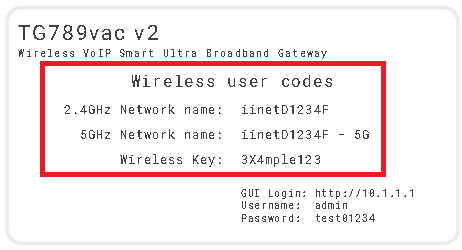
- We recommend connecting over the 5GHz Wi-Fi channel for faster performance. If your Wi-Fi’s running slow, check out Improving Wi-Fi Signal.
- For online gaming or HD/4K streaming, Ethernet is better than Wi-Fi. If you have extra Ethernet cables, you can connect up to 4 devices to your modem’s yellow LAN ports.
- To use your iiNet nbn Phone service, just plug a handset into your modem’s green Phone 1 port.
- You’re now good to go.
If you don’t want to keep your old modem, see if your local council has any eWaste recycling facilities.

